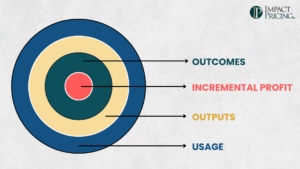You can listen to the full audio version of this blog we call — Blogcast.
Different buyers are willing to pay different amounts. This is a universal truth.
If you only have one product, then segmentation is simple to understand. You charge different prices to different customers based on their willingness to pay. This is called Price Segmentation and there are many techniques to help accomplish this.
However, once you start adding more products or versions of products–and almost every company I work with has many products–segmentation becomes much more tricky. It’s no longer just about price segmentation, you’ve got to consider market segmentation, portfolios, and packages.
At the highest level, you have Market Segmentation. Think of this as the general problems the customers are trying to solve. Let’s use a CRM system as an example. Is the problem to keep current customers happy? Is the problem to find new customers? Is the problem to help salespeople shepherd buyers through the sales funnel? These are three different problems.
Today, both HubSpot and Salesforce solve all these problems, but they do it with separate standalone modules. When the companies started, Hubspot focused on the marketing aspects, while Salesforce focused on the sales process. They had different market segments and they added new products specifically for these segments, and later added modules to attract the other segments.

Airlines may transport people or cargo. These are different market segments. Clearly defining your market segments is the most important part of segmentation.
Once you know your market segment(s), you can define a Product Portfolio for each segment. Every potential buyer in a market segment is trying to solve the same general problem, but it’s not necessarily causing them the same amount of pain. This is where you think of the size of the problem. How many salespeople are they managing? How many shipments do they send each year? What is the fallout if a shipment doesn’t arrive in time? For some customers, it’s a huge problem and they need all of the bells and whistles. For other companies, it’s not as big and they may get by with a minimum viable product.
When creating Packages, you want to enable your customers to choose the level that is best for them and guide them to the optimal combination of price and features for you. Always think first in terms of good, better, and best.
Once you’ve defined your market segments and designed your product portfolio and packages, you can use Price Segmentation for each individual product. Different buyers, even ones who want the same product, are willing to pay different prices. Price segmentation helps you capture more of what each buyer is willing to pay.
Hopefully, I made this sound relatively easy. We both know it isn’t. Pricing, marketing, and sales are complex, especially when changing the status quo. But remember, buyers are confused when deciding what they need. Confused buyers don’t buy. And without a framework like this, you have likely built a hodgepodge of products based on the loudest customers. You have probably created packaging and pricing that confused both your customers and your sales team. If so, you’ve made it hard for your buyers to buy.
My recommendation is that you try this framework. First define your market segments. Then try to define good, better, and best products for each segment. You will be shocked at the clarity it provides you … and your customers.
Share your comments on the LinkedIn post.
Now, go make an Impact!
 Tags: market segmentation, price, price segmentation, pricing, product packages, product portfolio
Tags: market segmentation, price, price segmentation, pricing, product packages, product portfolio













